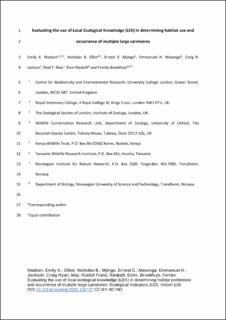Evaluating the use of local ecological knowledge (LEK) in determining habitat preference and occurrence of multiple large carnivores
Madsen, Emily K.; Elliot, Nicholas B.; Mjingo, Ernest E.; Masenga, Emmanuel H.; Jackson, Craig Ryan; May, Roelof Frans; Røskaft, Eivin; Broekhuis, Femke
Peer reviewed, Journal article
Accepted version

Åpne
Permanent lenke
https://hdl.handle.net/11250/2728067Utgivelsesdato
2020Metadata
Vis full innførselSamlinger
- Publikasjoner fra CRIStin - NINA [2364]
- Scientific publications [1392]
Originalversjon
10.1016/j.ecolind.2020.106737Sammendrag
Understanding habitat preferences and distribution of threatened species is a cornerstone of conservation, however many of the techniques available can be resource intensive. One cost-effective method is by collecting information on species presence and absence from people who regularly interact with the area of interest, also known as Local Ecological Knowledge (LEK). However, the reliability of this type of data has been questioned, especially when there is a possibility that the focal species is being misidentified or their presence misreported. This can introduce false negatives, when a species is present but has not been reported, and false positives, when the species has been reported but is not present. These biases are not always accounted for which can result in the under- or overestimation of species presence. To better understand the reliability of LEK data, we compared the outputs of five different analytical techniques to that of a more widely accepted approach, resource selection functions (RSF), using GPS-collar data from three different carnivore species (African lion Panthera leo, cheetah Acinonyx jubatus and African wild dog Lycaon pictus). Hierarchical models which accounted for the possibilities of both false negatives and false positives most closely matched that of the RSFs, especially for the two rarer species; African wild dog and cheetah. Our results show that when both false negatives and false positives are accounted for that LEK can be used as a rapid and cost-efficient tool for assessing threatened species which can be adopted into practical conservation projects. Carnivores Detection probability False positives GPS telemetry data Interview survey Occupancy models Species distribution
